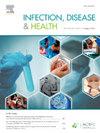化妆品测试器是耐药细菌的宿主和传播源。
IF 2
Q2 PUBLIC, ENVIRONMENTAL & OCCUPATIONAL HEALTH
引用次数: 0
摘要
背景:近年来,化妆品市场越来越受到关注。然而,关于这些产品细菌安全性的研究仍然很少。在这项初步研究中,我们旨在检测阿尔及利亚巴特纳市化妆品测试者和美容零售商中存在的耐抗生素葡萄球菌分离株。方法:于2019年5月,在不同的美妆零售商中,通过擦拭睫毛膏、口红、眼影、粉、腮红等不同类型的化妆品测试器表面,共收集325份样本。样品立即进行非选择性培养,然后进行选择性分离。代表性菌落鉴定采用基质辅助激光解吸电离飞行时间质谱(MALDI-TOF-MS)。采用琼脂扩散法进行药敏试验。结果:从不同类型的化妆仪中分离得到19株,鉴定为:mojavensis (n = 1)、溶血葡萄球菌(n = 4)、枯草芽孢杆菌(n = 3)、蜡样芽孢杆菌(n = 3)、扁芽孢杆菌(n = 1)、芽孢杆菌sp. (n = 1)、解淀粉芽孢杆菌(n = 1)、warneri葡萄球菌(n = 1)和4个未知种(n = 4)。药敏试验结果显示溶血葡萄球菌耐药水平最高。结论:化妆仪可能是耐药革兰氏阳性菌传播的宿主和途径。因此,要降低健康风险,提高公众安全意识,实施有效的控制措施和预防策略至关重要。本文章由计算机程序翻译,如有差异,请以英文原文为准。
Makeup testers as reservoirs and transmission sources of antibiotic resistant bacteria
Background
Recently, the cosmetic market has been attracting growing attention. However, studies on the bacterial safety of these products are still very rare. In this preliminary study, we aimed to detect the presence of antibiotic-resistant staphylococci isolates from makeup testers beauty retailers in the city of Batna, Algeria.
Methods
In May 2019, a total of 325 samples were collected by swabbing the surface of different types of makeup testers including mascara, lipstick, eye shadow, face powder and blusher in different beauty retailers. The samples were immediately subjected to non-selective culture, followed by selective isolation. Representative colonies were identified using matrix-assisted laser desorption ionisation time-of-flight mass spectrometry (MALDI-TOF-MS). Antimicrobial susceptibility testing was carried out by agar disk diffusion method.
Results
Nineteen isolates were obtained from the different types of makeup testers and were identified as: Bacillus mojavensis (n = 1), Staphylococcus haemolyticus (n = 4), Bacillus subtilis (n = 3), Bacillus cereus (n = 3), Bacillus pumilus (n = 1), Bacillus sp. (n = 1), Bacillus amyloliquefaciens (n = 1), Staphylococcus warneri (n = 1) and four unidentified species (n = 4). Antimicrobial susceptibility test results revealed that Staphylococcus haemolyticus presented the highest antibiotic resistance level.
Conclusions
These results showed that makeup testers may act as reservoir and pathway of antibiotic-resistant Gram-positive bacteria transmission. Hence, to reduce health risks and enhance public safety awareness, it is crucial to implement effective control measures and preventive strategies.
求助全文
通过发布文献求助,成功后即可免费获取论文全文。
去求助
来源期刊

Infection Disease & Health
PUBLIC, ENVIRONMENTAL & OCCUPATIONAL HEALTH-
CiteScore
5.70
自引率
5.70%
发文量
40
审稿时长
20 days
期刊介绍:
The journal aims to be a platform for the publication and dissemination of knowledge in the area of infection and disease causing infection in humans. The journal is quarterly and publishes research, reviews, concise communications, commentary and other articles concerned with infection and disease affecting the health of an individual, organisation or population. The original and important articles in the journal investigate, report or discuss infection prevention and control; clinical, social, epidemiological or public health aspects of infectious disease; policy and planning for the control of infections; zoonoses; and vaccination related to disease in human health. Infection, Disease & Health provides a platform for the publication and dissemination of original knowledge at the nexus of the areas infection, Disease and health in a One Health context. One Health recognizes that the health of people is connected to the health of animals and the environment. One Health encourages and advances the collaborative efforts of multiple disciplines-working locally, nationally, and globally-to achieve the best health for people, animals, and our environment. This approach is fundamental because 6 out of every 10 infectious diseases in humans are zoonotic, or spread from animals. We would be expected to report or discuss infection prevention and control; clinical, social, epidemiological or public health aspects of infectious disease; policy and planning for the control of infections; zoonosis; and vaccination related to disease in human health. The Journal seeks to bring together knowledge from all specialties involved in infection research and clinical practice, and present the best work in this ever-changing field. The audience of the journal includes researchers, clinicians, health workers and public policy professionals concerned with infection, disease and health.
 求助内容:
求助内容: 应助结果提醒方式:
应助结果提醒方式:


